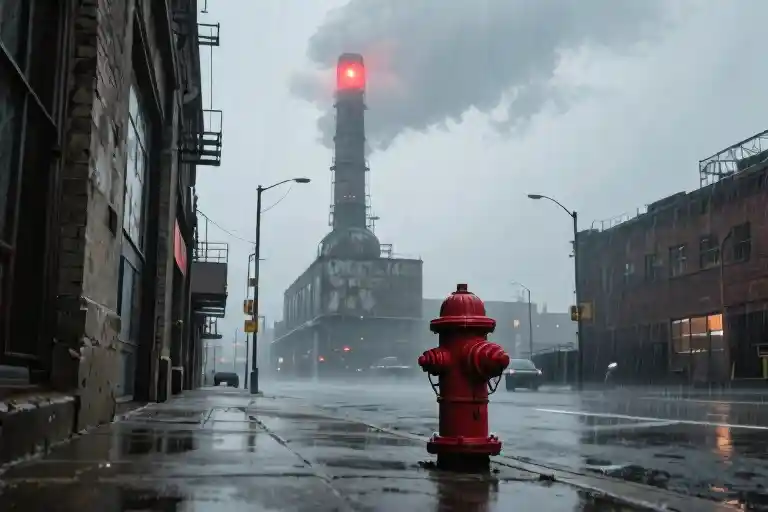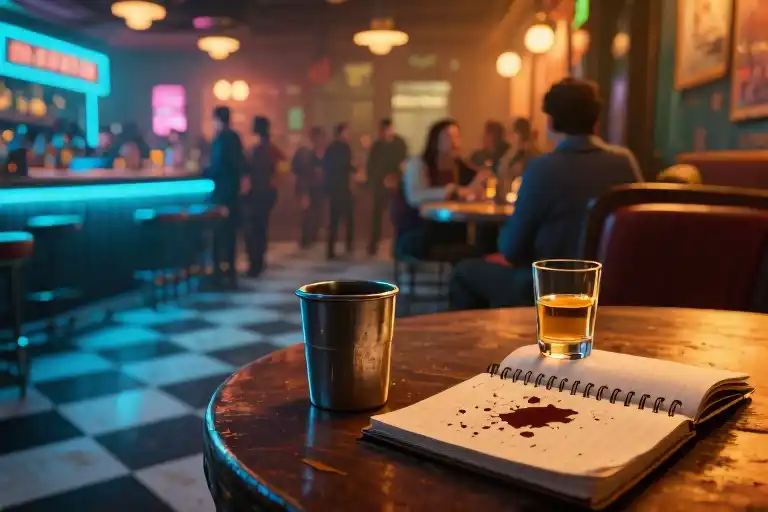The smokestack dissolves into low-hanging clouds, its concrete bulk fading like a half-remembered dream. That persistent red light pulses at the top—twelve seconds between flashes, I’ve counted—marking time in a way clocks never could. At knee-level, a fire hydrant crouches in municipal red, its paint chipped where generations of dogs have lifted their legs.
Between the disappearing tower and the grounded utility, life moves in measured chaos. A delivery man crosses the street with boxes stacked to chin level, his path intersecting precisely with the moment the smokestack vanishes completely behind vapor. The cardboard towers in his arms tremble with each step, threatening collapse but never quite falling. There’s poetry in how his shadow stretches long across the pavement while the industrial monolith disappears entirely.
Clouds thicken without announcement. What began as wispy cirrus now hangs heavy with the promise of nothing in particular. The red light persists, dimmer but determined, its glow diffusing through airborne moisture like a lighthouse beam through fog. I press a palm against the fire hydrant’s cool metal, feeling the dormant potential of pressurized water beneath iron skin. Somewhere above us all, steel birds trace concentric circles around the absent smokestack, their flight paths mapping invisible equations only they understand.
Static settles over the scene. Not silence—never that—but the particular hush of urban suspension. A shopkeeper two blocks down rolls his security gate shut for the last time. A windblown plastic bag snags on the hydrant’s protruding valve. The delivery man rounds a corner and becomes memory. Still the light blinks, slower now, or perhaps that’s just the clouds stealing its rhythm. Tomorrow the hydrant will remain, the clouds will dissipate, new boxes will need carrying. But today, in this suspended moment, the vanishing act feels absolute.
Industrial Totem Breathing
The smokestack never quite decides whether to be present or absent. Some days it stands defiant against the skyline, its concrete ribs visible through thinning clouds. Other times – like today – it dissolves into the atmosphere, leaving only that persistent red eye blinking at thirty-seven second intervals. I’ve timed it between sips of coffee, between the delivery man’s footsteps, between each silent prayer that floats upward and sticks to the underbelly of the clouds.
There’s an inverse relationship between the smokestack’s visibility and the weight it carries in my throat. The fainter its outline becomes, the more space it occupies in that hollow behind my Adam’s apple. Today’s particulates must be particularly dense – I can barely distinguish where industrial gray ends and sky gray begins. Only the beacon persists, its rhythm unchanged by human observation, a lighthouse for no one in particular.
The delivery man’s path intersects precisely with the vanishing point. As his dolly crosses an invisible coordinate, the smokestack winks out completely. Boxes labeled FRAGILE obscure what little remained visible, their cardboard corners slicing through my sightline. He never looks up, this man who unwittingly erases landmarks with his transit. His cargo could contain anything – porcelain figurines, laboratory glassware, ashes in decorative urns. The contents matter less than their temporary obstruction of that which should be permanent.
Red light persists. It’s the only certainty in this equation of disappearing things. Three flashes per minute, each pulse lasting exactly 1.8 seconds. I know this because I once stood in the rain for forty-three minutes counting, until the numbers lost meaning and became just another rhythm my heart could mimic. The constancy feels like mockery now – how dare this artificial star maintain its cadence while concrete giants fade and prayers go unanswered?
Sometimes I imagine the light isn’t a warning at all, but a pulse check. The smokestack taking its own vital signs, confirming it still exists despite the clouds’ attempts at assimilation. Blink. Still here. Blink. Still standing. Blink. Still waiting for someone to notice before condensation erases us all.
The Ecology of Waiting Rooms
The birds don’t circle so much as stitch. Their flight paths cross the smokestack at irregular intervals, tracing patterns that resemble hospital monitors when patients hover between states. I count seven dark shapes against the gray, though the number changes each time I blink – sometimes six, once nine. Their wings don’t flap so much as tremble, like the shaky lines of an EKG printout.
Beneath them, the patch of yellowed grass spreads its symptoms outward. The discoloration starts at the edges first, the way certain illnesses announce themselves with peripheral neuropathy before attacking major organs. Each blade curls inward upon itself, forming microscopic tubes that could be syringes or cigarette butts depending on the angle of observation. The soil beneath exhales a metallic scent when I press my palm against it, something between rust and chemotherapy.
Time here behaves like sedated patients – technically present but devoid of meaningful progression. The stillness isn’t peaceful but anticipatory, the kind that accumulates in pediatric oncology wards where wall clocks have second hands but no one believes in their measurements. Occasionally a breeze disturbs the scene, causing the birds to adjust their stitching slightly westward, realigning with some invisible pattern only they can follow.
At ground level, the dying grass forms perfect concentric circles radiating from the fire hydrant’s base. The red paint on the hydrant has faded to match the shade of old blood on gauze. When the delivery man passes by for the third time (or is it the same man with different boxes?), his shadow falls across the yellowed patches in a way that momentarily restores their greenness through optical illusion.
The smokestack’s blinking light marks time in units too large for human perception. Between each pulse, entire cellular processes complete themselves in the grass roots, tumors double their mass in unseen bodies, and prayers travel whatever distance prayers travel before dissolving. The birds continue their surveillance patterns, their flight paths now resembling the growth charts of stunted children – jagged peaks followed by alarming plateaus.
Sometimes a single feather detaches and spirals downward, taking minutes to cover what should be seconds of descent. I watch one particular feather’s progress until it lands precisely on the border between healthy and yellowed grass, the quill pointing toward the toppled street sign up the block. The vanes tremble briefly before going still, another minor event logged in the waiting room’s endless ledger of inconclusive data.
Urban Excavation Site
The traffic sign leans at precisely 23 degrees – not enough to suggest violent impact, but sufficient to reveal the asphalt’s subtle curvature. Its aluminum edge catches the afternoon light differently now, throwing elongated shadows that point toward the shuttered pharmacy. Three parallel scratches mark the post where delivery trucks graze it during tight turns, each groove collecting rainwater and motor oil in equal measure.
What fascinates me isn’t the sign’s fallen state, but how pedestrians adjust their gait to avoid its shadow. They’ll sidestep the actual obstruction without breaking stride, yet instinctively avoid stepping on the darkened pavement where it no longer stands. The city remembers structures longer than people do.
Across the street, the former bookstore’s display window reflects distorted versions of passersby. The glass warps bodies at the waist, stretching torsos into grotesque proportions while compressing legs into stubby projections. A woman checking her phone becomes a floating head with elongated fingers; a cyclist transforms into a spinning wheel with fragmented limbs. These accidental funhouse mirrors reveal more truth than the polished surfaces along the commercial district.
I count the boxes in the deliveryman’s arms each time he passes – seven yesterday, nine today. Their increasing bulk contradicts the neighborhood’s economic decay. The packages bear no retail logos, just stark white cardboard secured with excessive tape. He never uses a dolly, always carrying them flush against his chest like a man transporting his own organs for transplant. At 3:17 PM precisely, he’ll pause near the leaning sign to adjust his grip, though the packages never actually slip.
These urban artifacts form their own archaeology. The angle of a fallen sign indicates prevailing wind patterns. The depth of scratches on metal posts chronicles delivery truck routes. Even the growing stack of boxes charts some unseen economy flourishing beneath the visible decay. I document them not to preserve, but to understand how cities shed their skins while keeping the same skeletal structure.
The pharmacy’s security grate still bears ghost letters from removed signage – a faint ‘RX’ visible only when morning light hits at 72 degrees. Like the traffic sign’s persistent shadow, these urban scars outlast their causes. Tomorrow the deliveryman will carry eleven boxes. The next day, thirteen. The arithmetic progression feels less like commerce than ritual, as if he’s building some invisible ziggurat one parcel at a time.
Sometimes I press my palm against the bookstore’s warped glass to see my own reflection elongate. The distortion shows what we might become if urban loneliness had its way – all stretched intentions and compressed connections. The deliveryman never looks at his reflection. He’s too busy counting steps, measuring breaths, maintaining the precise pace that keeps his tower of boxes from toppling.
The Unanswered Prayer
The words form in my throat like concrete – ‘find the strength to get away from me’ – a daily incantation that tastes of rust and diesel fumes. This prayer doesn’t rise toward heaven but sinks into sidewalk cracks, joining the gum wrappers and cigarette butts of other abandoned hopes. We both know where prayers go in this neighborhood: they evaporate with the morning steam from manhole covers, get swept into storm drains with last night’s rainwater.
Closing my eyes doesn’t bring revelation, only afterimages of industrial shapes burned onto my eyelids – the angular silhouette of the fire hydrant, the rectangular stacks of the delivery man’s boxes. Even in darkness, the city persists. That blinking red light on the smokestack pulses behind my closed lids like a failing heartbeat monitor, its rhythm syncopated by the delivery man’s footsteps.
The clouds have thickened since morning, a slow condensation of urban exhaust and gathering despair. Visibility drops with the temperature, turning the smokestack into a ghost of itself. Sometimes I wonder if it ever existed at all, or if we collectively hallucinated these industrial monoliths to explain our persistent coughs. The birds seem real enough though – three dark specks circling endlessly, their flight paths tracing the same patterns as hospital waiting room clocks.
Alienation settles in like the afternoon haze. That knocked-over street sign hasn’t been righted, its metal pole bent at the same angle as the delivery man’s spine under his load. The vacant storefront down the block still displays its final ‘Going Out of Business’ announcement from last winter, the letters bleeding like the yellowed grass around the hydrant. Everything persists except what matters – the birds will migrate, the delivery man will clock out, the unanswered prayers will accumulate like sediment.
Magical realism isn’t about inventing wonders; it’s about noticing how reality already performs its own sleight-of-hand. The smokestack disappears behind vapor while remaining physically present. Prayers vanish despite being spoken aloud. We navigate by these absences more than by what remains visible. My novel-in-progress tries to map these disappearances – not to recover what’s lost, but to document the exact moment when solid things turn to smoke.
Roman’s Workshop: This week I’m experimenting with object permanence in prose. How many times can the smokestack vanish and reappear before readers question its existence? What happens when we treat prayers as physical objects with weight and trajectory? Follow my Substack for drafts and dead ends.
The Emergence of a Writer’s Voice
The text fractures suddenly, like pavement giving way to an unexpected sinkhole. Where there was smoke and blinking lights and the weight of industrial solitude, now stands a name: Roman. The transition feels less like an authorial signature and more like a character stepping out from behind the curtain of metaphors. This is how modern literary identities form—not through grand pronouncements, but through the quiet accumulation of obsessions (smokestacks, delivery men, the particular shade of dying grass) that eventually coalesce into what we call a writer’s voice.
Magical realism announces itself through absence here. The novel’s title remains deliberately unfinished—20xx—as if the work exists simultaneously in multiple timelines. That blinking red light from earlier? It might be a distress signal from the future. The vanished smokestack? Perhaps it never existed in this dimension. Good magical realism never explains its tricks; it simply lets the reader notice that the seams between reality and fantasy were always illusory.
Substack becomes the perfect contemporary epilogue. No “THE END” in bold letters, just a hyperlink humming with potential. In an age where stories never truly conclude but merely pause between updates, the platform transforms the writer-reader relationship into something more intimate than traditional publishing allows. Those circling birds from earlier passages? They’ve migrated here, carrying fragments of unfinished narratives in their beaks.
What makes this emergence work is its resistance to grandeur. The writer doesn’t proclaim their artistic manifesto; they simply note that most days include prayers for separation alongside observations of hydrants and delivery routes. There’s power in this juxtaposition—the sacred and mundane occupying the same mental space, much like how magical realism insists the extraordinary lives in our laundry rooms and subway commutes. The clouds may have thickened, but the light still pulses. However faint. However slow.





